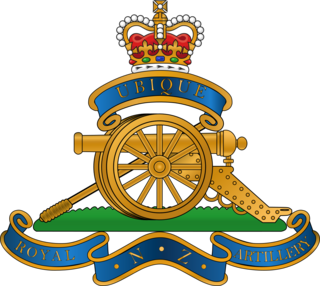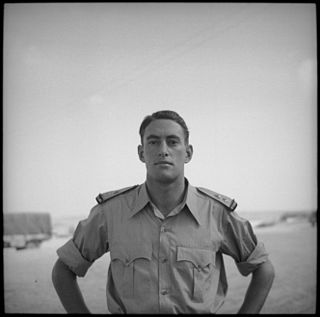
The Royal Regiment of New Zealand Artillery is the artillery regiment of the New Zealand Army. It is effectively a military administrative corps, and can comprise multiple component regiments. This nomenclature stems from its heritage as an offshoot of the British Army's Royal Artillery. In its current form it was founded in 1947 with the amalgamation of the regular and volunteer corps of artillery in New Zealand. In 1958 in recognition of services rendered it was given the title the Royal Regiment of New Zealand Artillery.

The 3rd Field Regiment, Royal New Zealand Artillery was a territorial force Field Artillery regiment of the New Zealand Army. The unit was formed in 1921 and consisted of the field artillery batteries based in the South Island. The regiment remained in New Zealand during the Second World War and was tasked with training reinforcements for 2nd New Zealand Expeditionary Force. The regiment was disbanded in 1990.

The 11th Coast Regiment, Royal New Zealand Artillery was a territorial coastal artillery regiment of the New Zealand Army based at Godley Head. The regiment was formed in 1940 as 11th Heavy Regiment, New Zealand Artillery and controlled the coastal defence batteries around Lyttleton Harbour. The regiment was progressively expanded and by the end of the war had batteries all over the upper North Island. The regiment was reduced to a cadre in 1957 and disbanded in 1967, along with the other coastal artillery regiments.
The 5th Division, New Zealand Military Forces, was raised in the Southern Military District during the Second World War. It consisted of the 3rd and 10th Brigades and the 11th Brigade Group. It was disbanded after the danger of invasion from Japan receded. It appears to have been raised on 1 November 1941, and disbanded on 1 April 1944.

Lieutenant General Sir Leonard Whitmore Thornton, was a senior officer in the New Zealand Army.

The 1st Brigade is currently the largest unit of the New Zealand Army, and contains most of the army's deployable units. The brigade was formed on 13 December 2011 by amalgamating the 2nd Land Force Group and 3rd Land Force Group. Its establishment formed part of the 'Army 2015' package of reforms.
The 1st Division was one of three New Zealand Army home defence divisions formed during World War II. The unit was established on 1 November 1941 and was responsible for protecting the northern region of New Zealand's North Island from invasion. The 1st Division was placed on alert during the early months of the Pacific War, but no threat developed. The division was greatly reduced in size during 1943 and was disbanded on 1 April 1944.

56th (Cornwall) Heavy Anti-Aircraft Regiment, Royal Artillery was a volunteer air defence regiment of Britain's Territorial Army (TA). Originally raised in 1920 as a medium artillery regiment, it was converted to the anti-aircraft role in 1932. During the Second World War, it was employed in Home Defence, in Iceland and then in India, where it was temporarily converted back to medium artillery. Postwar, it reverted to air defence until disbandment in 1955.

15th Anti-Aircraft Brigade was an air defence formation of the Royal Artillery which saw service during the middle years of the Second World War. The brigade was formed in Gibraltar to control those anti-aircraft (AA) units based there and disbanded shortly after the air threat had been diminished in 1944. The brigade was later reformed in 1947 as part of the post-war regular army, but disbanded in 1957 following the end of the AA era.
The 10th Infantry Brigade was a brigade of the New Zealand Military Forces formed on two separate occasions during the Second World War. The brigade was first formed as part of the 2nd New Zealand Division, just prior to the Battle of Crete. It consisted of a variety of New Zealand artillery and support units operating as Infantry, as well as two Greek Infantry regiments. The 10th Brigade was absorbed by 4th Brigade part way through the battle. The 10th Brigade was formed for the second time in New Zealand as a territorial force formation in November 1941 and became part of the 5th Division. By 1944 the threat of Japanese invasion was perceived to be minimal and the 10th Brigade was disbanded.

The 4th Medium Regiment, Royal New Zealand Artillery was a territorial artillery regiment of the New Zealand Army based in the Waikato. It was formed in 1948 and initially equipped with 6 inch howitzers, although these were replaced with 5.5 inch guns in 1951. The regiment received the freedom of the city of Hamilton, New Zealand in 1960 and bore the city's coat of arms on their guns. The regiment was disbanded in 1961.

The 13th Composite Anti-Aircraft Regiment, Royal New Zealand Artillery was a territorial air defence regiment of the New Zealand Army. The regiment was formed in 1948 and disbanded in 1956, with its heavy battery being transferred to the newly formed 12th Heavy Anti-Aircraft Regiment.

The 14th Composite Anti-Aircraft Regiment, Royal New Zealand Artillery was a territorial air defence regiment of the New Zealand Army. The regiment was formed in 1948 and disbanded in 1956, with its heavy battery being transferred to the newly formed 12th Heavy Anti-Aircraft Regiment.

The 15th Composite Anti-Aircraft Regiment, Royal New Zealand Artillery was a territorial air defence regiment of the New Zealand Army. The regiment was formed in 1948 and disbanded in 1954. Its heavy battery briefly became an independent unit, before becoming part of the newly formed 12th Heavy Anti-Aircraft Regiment in 1956.

The 2nd Field Regiment, Royal New Zealand Artillery was a territorial field artillery regiment of the New Zealand Army. It was originally formed as 2nd Field Artillery Brigade in 1921 and brought the independent batteries of the Wellington area under a single command. In 1940, the New Zealand territorial artillery brigades were redesignated as regiments and the former batteries became troops within new, larger batteries. During the Second World War, the 2nd Field Regiment remained in New Zealand for home defence as part of the 4th Division. After the war, the regiment remained a part of the territorial force until it was disbanded in 1964. The regiment was briefly reformed in 1982 to provide command support to 22(D) Battery, but was disbanded the next year.

The 1st Field Regiment, Royal New Zealand Artillery was a territorial field artillery regiment of the New Zealand Army. It was originally formed as 1st Field Artillery Brigade in 1921 and brought the independent batteries of the Auckland Area under a single command. In 1940, the New Zealand territorial artillery brigades were redesignated as regiments and the former batteries became troops within new, larger batteries During the Second World War, the 1st Field Regiment remained in New Zealand for home defense as part of the 1st Division. After the war, the regiment remained a part of the territorial force until it was disbanded in 1964.

The 10th Coast Regiment, Royal New Zealand Artillery was a territorial coastal artillery regiment of the New Zealand Army. The regiment was formed in 1940 as 10th Heavy Regiment, New Zealand Artillery and controlled the coastal defence batteries around Wellington Harbour. The regiment was progressively expanded and by the end of the war had batteries all over the lower North Island. The regiment was reduced to a cadre in 1957 and disbanded in 1967, along with the other coastal artillery regiments.

The 9th Coast Regiment, Royal New Zealand Artillery was a territorial coastal artillery regiment of the New Zealand Army. The regiment was formed in 1940 as 9th Heavy Regiment, New Zealand Artillery and controlled the coastal defence batteries around Auckland. The regiment was progressively expanded and by the end of the war had batteries all over the upper North Island. The regiment was reduced to a cadre in 1957 and disbanded in 1967, along with the other coastal artillery regiments.

The 6th Light Anti-Aircraft Regiment, Royal New Zealand Artillery was a territorial air defence regiment of the New Zealand Army. It was formed in 1948 and equipped with 40mm Bofors anti-aircraft guns. The regiment was disbanded in 1961.

The 5th Anti-Tank Regiment, Royal New Zealand Artillery was a territorial artillery regiment of the New Zealand Army. It was formed in 1948 and was equipped with 17-pounder anti-tank guns. In 1949 it was decided to convert the regiment to self-propelled 25-pounders and to add a troop of 4.2 inch mortars, similar to the organisation of 7th Anti-Tank regiment during the latter phases of WWII. The conversion, however, was never completed and the regiment was disbanded in 1950. A 4.2 inch mortar battery was subsequently formed and would go on to become 5th Light Regiment.





